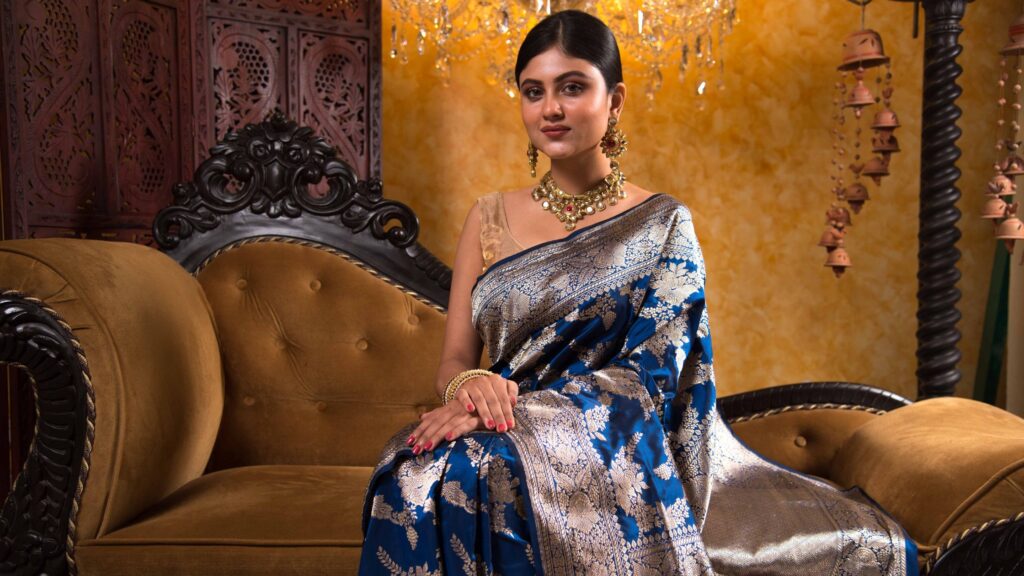History of Banarasi Saree: A history of silken legacy
Kashi, as Banaras is still known is a city immemorial and is said to be the favorite earthly residence of Lord Shiv. The city, with each alley and lane telling its own story and singing a narrative unique to itself has for ages been a center for theosophy, philosophy, literature and art. With its own Gharanas in popular art forms like Kathak and vocal music, it have birthed many legends and is still nurturing talents in its lap.

Among these was Sant Kabirdas, a weaver by profession and legendary theosophist who is renowned for being one of the proponents of Universal Brotherhood. However, one must know that Kabirdas ji was a weaver of cotton, and not silk as many might not even know. Why cotton? Because silk was not an attainable dream for the common. Here, we are weaving tales of grandeur, a fascinating exploration of Banarasi saree history for you.
Silk found its way to India
Centuries back, as history supports, India was birthing, weaving and upskilling the various weaving traditions from the indigenous cotton. Silk has its origin in China and owing to the Silk Route, other Asian countries and even the Eastern Europe was exposed to the sheen of silk by the traders dealing in Chinese produces. Thus, in the ancient and until the medieval times, the precious silk was either a choice of fabric for the Gods and deities, or it was restricted to the royals and the courts. Due to the labor intensive and care driven silk production, the already expensive fabric was adorned with gold, silver and silken embroidery inspired from the nature and the religious myths and deities, thus making it a dream. However, times changed and Silk reached the normal people in the medieval times and added to a fascinating exploration of banarasi saree’s history for us.
Mughals and the Banarasi Saree history
It was in the court of the Mughal kings, mainly from the time of Akbar and Jehangir that silk became available to the royalty and the wealthier echelons of the society as well. It is thanks to the Mughal influence that the patterns like fleur-de-leys, geometrical jali patterns and garden motifs in meenakari and colorful silk threads started becoming the trend. However, the ancient Chinese and Asian influences also continued and the motifs only got richer by the day for this majestic weave. Then came the downfall of the Mughals after Aurangzeb’s descendants failed to keep the empire and the artisans who enjoyed patronage fled to other royal clans for support. A branch of the Mughals came and settled on the Gangetic banks of Varanasi and that’s how, in the 17th century the art flourished further.

It is known that as Varanasi flourished and fishing became a restricted activity due to the highly religious beliefs, an entire village of Nishads (fishermen) gradually reinvented their trades and became weaves and thus, you would be able to hear weaving machines go thud and plonk from the windows of every household thus weaving a majestic tale filled with shiny grandeur. Sarai Mohana, the aforementioned village at the banks of river Varuna became a center for buyers and merchants seeking the finesse and beautiful Banarasi handloom sarees defining and redefining royalty.
The process of weaving each saree had a complex cycle and the meticulous approach would ensure the designs to be adapted accurately thus maintaining the majestic grandeur and aura. But the designing itself was not easy.
Artisans and not Weavers
Each saree takes approximately 8–10 days at least even in the olden days of the Banarasi saree’s history. The more complex the design, the more time taking it could be. If the sarees are customized then the process is fairly time-taking and labor intensive. Why do you think we call the Banarasi weavers, artists and not mere weavers? There is a profound reason behind this. Historically, when Banarasis began to be made, the motifs were a collage of cultures from there the silks travelled or the weavers and their patron arrived. For instance, you might the peacock and parrots in motifs and these were taken from the traditional Maharastrain paithani weaves.

Like we mentioned earlier in the piece that fleur-de-leys and other geometric patterns like jaal, semi-circular arches, and others were from the Middle Eastern and Eastern European influences. The mythological characters and incidents were inspired from the Eastern Indian influences such as Baluchari and Sonarchuri. While one can say that the metallic hues were infused from inspirations from Pochampally and Kanjeevaram patterns. While we can keep finding more hints and influences, but then imbibing influences from such a vast cultural compass into one seven-yard take was arduous.
All richness of weaving history being unified in the Banarasi saree is fascinating and makes the exploration of the tales of this weave worthy.
Banarasi saree: History of weaving
There was a time when the weaving was really handspun silk threads that were woven into sarees using stones for weights and wooden structures to hold the structures together. Usually now we refer to that kind of weaving machine as a heddle loom. But then the Europeans brought changes. The present day pit loom technique was a French influence where the entire loom would be set in a pit within a room or hall and the weaver would sit with his feet in that pit to peddle the loom into action.
Designing has also evolved adding to tales of grandeur for this regal weave. The original system was a designer called nakshaband preparing a detailed design sheet called likhai on papers that the weavers were supposed to implement it meticulously.

Later, as the pit looms arrived, the designing also changed. The artisans then did not copy the design by referring to a design sheet, but these designs were punched into a string of cardboard cards that are then arranged in a sequence through strings. This is how you the traditional banarasi handlooms are made now.
Reviving the Glory
In the 1900s as the industrial revolution took over and machines produced banarasi sarees at a faster pace, the traditional artisans lost their livelihood and the silken regality and fascination also reduced. Maybe it was the fear of the loss of a geographical index or a traditional art getting lost behind materialism, the governments were also quick to act. The areas like Azamgarh, Mubarakpur, Jaitpura, Madanpur are still homes to Banarasi weavers where each day, as the sun stretches into the sky, you can hear the thuds and thumps of the pit looms, with artisans weaving tales of the silken legacies with the imported silk. The protection to their generational gifts making them safer.
Final Words
Varanasi, an ancient city, is home to art and culture where the Silk found a new epochal rebirth as the Mughals and royal patronages, combined with the love of the artisans for this unparalleled weave, created the majestic tale of the regal Banarasi handloom sarees and dress materials. A weave that talks of a united India through the various art forms imbibed and the retained history of its journey, this is a glimpse into the right history of renowned Banarasi Saree!
Sacred Weaves
An online store that welcomes you into the old world charm that speaks of the revival of the heritage of Banarasi weaves, Sacred Weaves has been nurtured under the legacy of JDS Banaras. This online store boasts of a collection that is easy to find lovers across all ages, be it the regal lovers of the older generations, or the younger beauties that seek royal splendor with more comfortable fabrics. The special treatment that is unique to Sacred Weaves is their online guided shopping experience which you can book by merely through their website.
Image Credits:
- isha.sadhguru.org
- www.insightsonindia.com
- www.dsource.in

